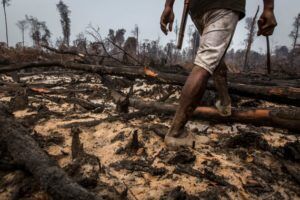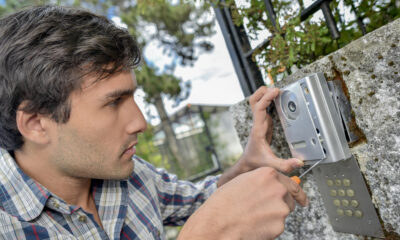

Environment
Could Asbestos Be A Hidden Danger of Extreme Weather?
Australia’s bushfires are part of a growing trend – worsening bushfires and other extreme weather around the world. But could asbestos be a hidden threat?
If you’ve been watching the news recently, it will have been hard to avoid what’s going on in Australia. Record temperatures have led to bushfires that have been raging for months, destroying millions of acres of scrubland, forests and parks. As well as having a devastating impact on the country’s flora and fauna, the wildfires have also encroached on human settlements, and led to the loss of dozens of lives.
While the effects of wildfire smoke on air quality have been well documented, there may be a less appreciated threat: that of deadly asbestos. Australia has a legacy of asbestos use that’s worse than most countries, and it seems likely that many of the buildings consumed will have contained the substance. The threat of wildfires – and other extreme weather events around the world – should be a warning that our passive policies towards the substance may be due for a change.
Asbestos in Australia
Like many developed countries in the 20th century, Australia was enamoured with asbestos. Asbestos products drove construction efforts in the post-WW1 and WW2 periods, despite the health effects of asbestos being recognised as early as 1898. Asbestos was widely used in asbestos cement (known as ‘fibro’), roofing and fencing, as well as loose fill roof and cavity insulation. By the mid 1960s, at least 20% of all Australian housing stock contained asbestos.
Driving this boom in asbestos products was the Wittenoom crocidolite asbestos mine, one of the largest and most active asbestos mines in the world. Wittenoom was Australia’s only supplier of blue asbestos, and remained open between 1943 and 1966. By 1986, there were 85 confirmed deaths from mesothelioma alone traced back to the Wittenoom mines. The town would eventually be degazetted – have its town status removed – and removed from all maps and signs in 2007, and is now an asbestos-riddled ghost town.
The most dangerous forms of asbestos continued to be used in Australia right up until the late 1970s, and asbestos products in general remained popular until the late 1980s. Action to remove loose fill asbestos insulation began in 1989, and was still ongoing as recently as 2014, when the government agreed a buyback of many affected properties. Asbestos was not completely banned in Australia until 2003, and the country still has one of the highest death rates from asbestos-related diseases in the world.
Asbestos law
Asbestos remains an issue in Australia, as it does in many countries around the world. As with those other countries, action is being taken to prevent asbestos from becoming an active threat, but not necessarily to remove it. While asbestos must be removed from commercial buildings where it presents a threat to health, this usually only includes asbestos which is friable (such as loose fill or lagging), and not asbestos which is considered stable, such as tiles and boards.
Asbestos laws also only apply to businesses and not individuals, meaning that degrading asbestos may be present in thousands of homes around the country, and many more around the world. This isn’t the worst approach – asbestos containing materials (ACMs) do not pose an active risk if they remain undamaged, and removing them raises the risk of exposure.
However, such asbestos laws often underestimate the potential for accidental damage, or indeed the effects of inclement weather. Take the example of asbestos in schools: while wall tiles may be considered stable, students may pick at or otherwise damage them without realising. The same may be true of asbestos in a business setting, where vehicles or tools could cause accidental damage, as well as the possibility of water damage or other accidents.
Weather warning
While there’s no specific evidence to suggest that asbestos is an issue in the current wildfires, it seems inevitable given the age of many of the buildings affected, and the amount of asbestos still present in the country. The effects of smoke from house fires are already severe, with the chemicals in common materials stunting growth in children, and causing breathing problems and infections in adults. It’s estimated that wildfire smoke exposure in the U.S. causes 20,000 premature deaths, and the scale of fires in Australia is even larger.
Combining asbestos with this existing smoke damage could be a deadly cocktail, and is a tangible threat to life. The recent fires have shown that previous protocols for preventing the spread of fire have failed, as the heat is so intense in places that embers are carrying for miles, and causing houses to ignite. Asbestos fibres could easily travel the same distance, spreading the substance across huge areas and exposing thousands of people.
Evidence suggests that wildfires will be an increasing problem as global temperatures rise, not just in Australia but around the world. The frequency and severity of wildfires has been increasing in the U.S. too, as demonstrated with the deadly Camp Fire last year. And wildfires are not the only phenomenon that could damage and spread asbestos, with incidents of tornadoes, hurricanes and other extreme weather also increasing. Any of these issues could easily damage ACMs and spread asbestos dust, causing decades of health issues.
Conclusion
Current strategies around asbestos assume that it is always possible to maintain ACMs, and that it’s easier and safer in many cases to preserve rather than remove them. The increasing unpredictability of weather around the world throws this into question, and should prompt a serious rethink. If we’re too slow to act, damage to asbestos could be exacerbated – causing a legacy of death and illness that will last for another half a century.






























